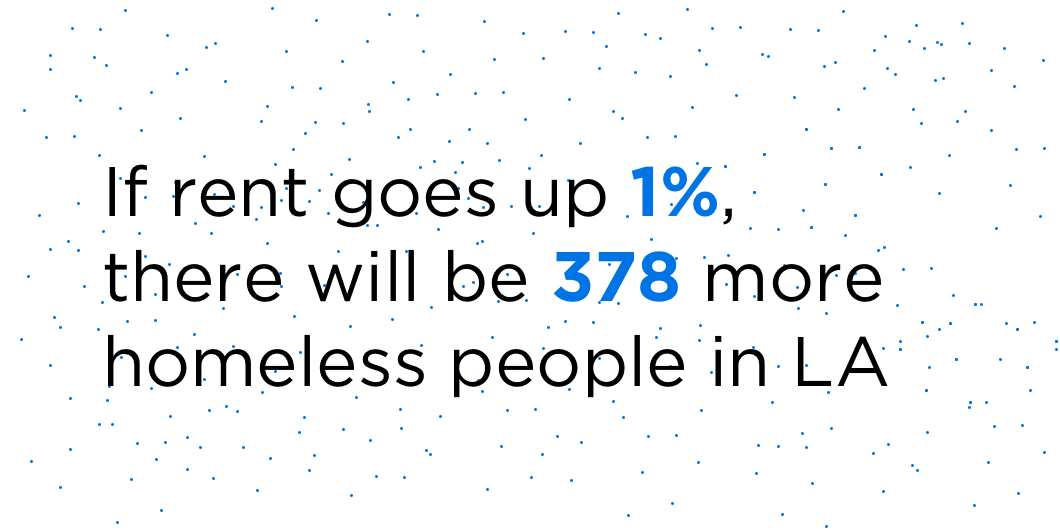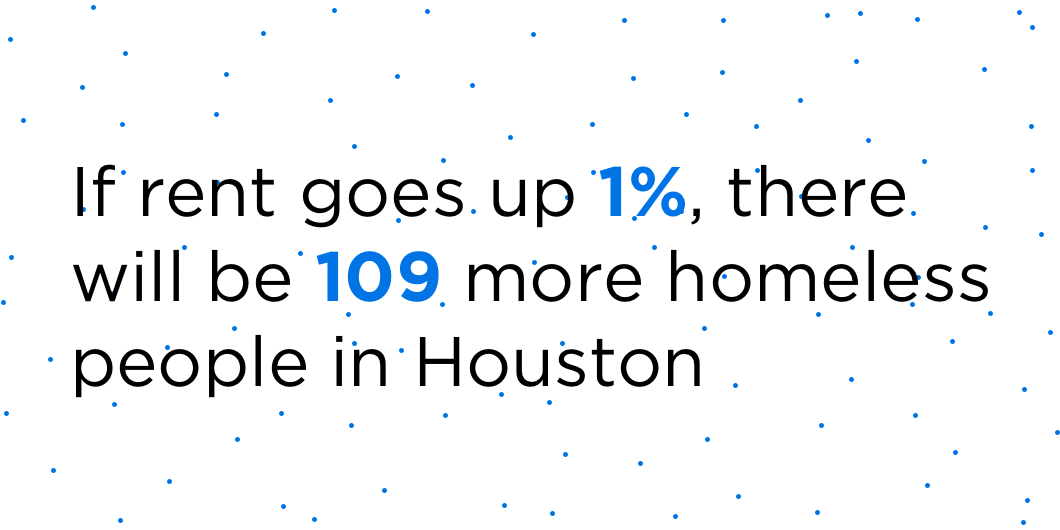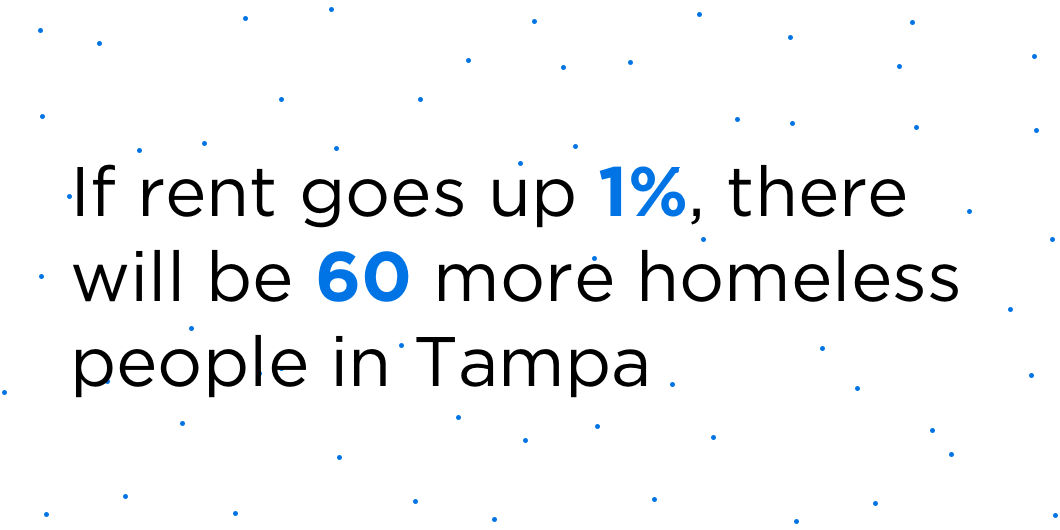These vignettes about two metro areas in a homelessness crisis — New York and Los Angeles — and two that have managed to interrupt the tie between rising rents and growing homelessness — Houston and Tampa — are part of a broader package examining how rising rents lead to more numbers of people experiencing homelessness. See below for the primary research and other articles on this subject.
New York
Metro population: 20.2 million
Homeless population (2016)*: 76,411
Zillow Rent Index (June 2017): $2,376, down 1.6 percent from a year earlier
Estimated gain in homeless population if rents rise 5 percent: 2,982

New York has the most people experiencing homeless in the country — and its count is more accurate than many metros, because, by law, the city is required to shelter people who are experiencing homelessness. Rents are so high in New York that “we see lot of families that already have one or two jobs and are still unable to make ends meet,” said Raysa Rodriguez, vice president of policy and planning for Women in Need, which provides shelter and supportive services to families in New York. They want to break the cycle by which homeless children become homeless adults, and providing long-term support is key throughout the system, she said. “It’s often more cost effective than having them come into a shelter, then go into temporary housing that expires, and they’re right back in the shelter.”


To house a single adult in a shelter cost $94.57 a day in 2016, the city reported. A single family costs $120.22 a day. Most stay more than a year. A basic problem, here and elsewhere, is that there aren’t enough units to house the homeless population — and the city has resorted to using hotels as shelter space. “The city has made some positive efforts in reinstating access to public housing, Section 8 and city-funded subsidies for homeless households, but it has not matched the scale of the problem we currently have,” said Giselle Routhier, policy director for the Coalition for the Homeless in New York. “We need to double down on the solutions we know work – utilizing the New York City Housing Authority to its fullest capacity and deeply subsidizing units within the city’s housing plan specifically for homeless households.”
Los Angeles
Metro population: 13.3 million
Homeless population (2016)*: 59,508
Zillow Rent Index (June 2017): $2,682, up 4.2 percent from a year earlier
Estimated gain in homeless population if rents rise 5 percent: 1,993

“I hate to use the term ‘affordable housing,’ because all housing is affordable for somebody. It just so happens that the housing they’re building is not matching the needs of the working individuals of Los Angeles,” said Mike Neely, former commissioner of the Los Angeles Homeless Services Authority. Homelessness does not come with a one-size-fits-all solution, he said. “Part of the problem is that we’ve locked ourselves into singular kinds of solutions, and we’re not looking at what the broad-based problems are.” Federal funding often comes with terms attached that Neely believes “killed the innovation.” As a result, “You solve certain problems, but some of the more intractable problems, you don’t get to really and truly reach.”


An example is some types of housing assistance that are tailored with specific supportive programs for people who are mentally ill or have disabilities, but do not necessarily help someone who became homeless because of, say, high medical costs. “They say those individuals should be assisted using rapid rehousing, but what happens when that subsidy runs out?” Neely asked. “We’ve got to throw out the old playbook and put everything on the table.” Possibilities he tossed out include tiny houses, prefabricated units to save on building costs, and converting shopping malls to include micro-sized apartments. Orlando Ward, executive director of external affairs for Volunteers of America of Greater Los Angeles, was homeless for years. Skyrocketing housing costs have to be addressed, he said. Because of how unaffordable the area is to all but the highest income groups, “you have people buying housing a rung or two below where they should be buying and that squeezes the people at the very bottom.”
Houston
Metro population: 6.8 million
Homeless population (2016)*: 5,032
Zillow Rent Index (May 2017): $1,538, down 2.8 percent from a year earlier
Estimated gain in homeless population if rents rise 5 percent: 120

Just five years ago, Houston had one of the worst homeless counts in the country. Now it’s dropping fast, and our research shows that even a hefty 10 percent uptick in Houston rents would result in just 135 more people experiencing homelessness — far below the 6,048 people projected to become homeless if New York saw that magnitude of a rent increase. “It’s understandable, because in Houston, so many units specifically target homeless people,” said Philip Mangano, who was the country’s homeless czar under George W. Bush. One way the area adds units is through coordinated marketing to landlords — an effort that began in earnest after the leadership turned over at several local agencies and organizations fighting homelessness. In 2012, Marilyn Brown was hired as president and CEO of Houston’s Coalition for the Homeless, and she has worked with dozens of other groups to create a new direction for ending homelessness. They use a master database to hone their focus, Brown said.


“We have to go where the data are taking us; we have to spend our dollars working with the most vulnerable, and therefore the costliest, people.” They’ve even turned away private funding aimed at niche groups that are not yet part of their focus. Houston also has a Rapid Rehousing program for people who do not require long-term assistance. It was harder to implement than they expected, but ultimately worth it. Eva Thibaudeau, the coalition’s director of programs, told the Institute for Children, Poverty & Homelessness, “As we often say to each other when we get really frustrated, we are the ones with an office and roof over our heads. We are not the ones in crisis or in a state of shock. We should be the ones doing the heavy lifting.”
Tampa
Metro population: 3.0 million
Homeless population (2016)*: 3,090
Zillow Rent Index (June 2017): $1,353, up 1.7 percent from a year earlier
Estimated gain in homeless population if rents rise 5 percent: 69

Ask Larry McKinnon in the Hillsborough County Sheriff’s Office why the area’s homeless count has dropped in recent years, and he tells a story: “Our relationship with homeless people had always been adversarial,” he said. Deputies would see the same people on the street in and around Tampa, until about seven years ago when a deputy realized that many of them could get jobs if they just had identification. “We started making connections to the Social Security and driver’s license offices. Then we started getting them places to live,” McKinnon said. He calls it “priming the well.” Rather than shuffle people experiencing homelessness from one area to the next, the office has a staff of eight deputies whose full-time job is to figure out what they need and get it for them. “A lot of times we help them get back on their medication, and that’s all it takes,” McKinnon said.


They proudly document their successes on Facebook. “I’ve been doing this for 40 years, and I’ve talked to a lot of people in their situations. You’d be surprised how many were accountants, lawyers, policemen, anybody.”
In part because of those efforts, Tampa has come a long way since 2012, when the Republican National Convention came to town and shined a light on its homelessness problem.
Another shift came in 2014, when the Tampa Hillsborough Homeless Initiative coordinated the placement of dozens of veterans experiencing homelessness into furnished apartments with supportive services on a single day: Veterans Day. The area’s population of homeless veterans has dropped from 236 to 172 people, said Antoinette Hayes Triplett, the initiative’s CEO — and a veteran.
*This figure differs from each area’s officially recognized homeless count, and is Zillow’s estimate of the true number of homeless individuals in an area. It is based on HUD data, an formulated using our statistical methodology.
Related:








